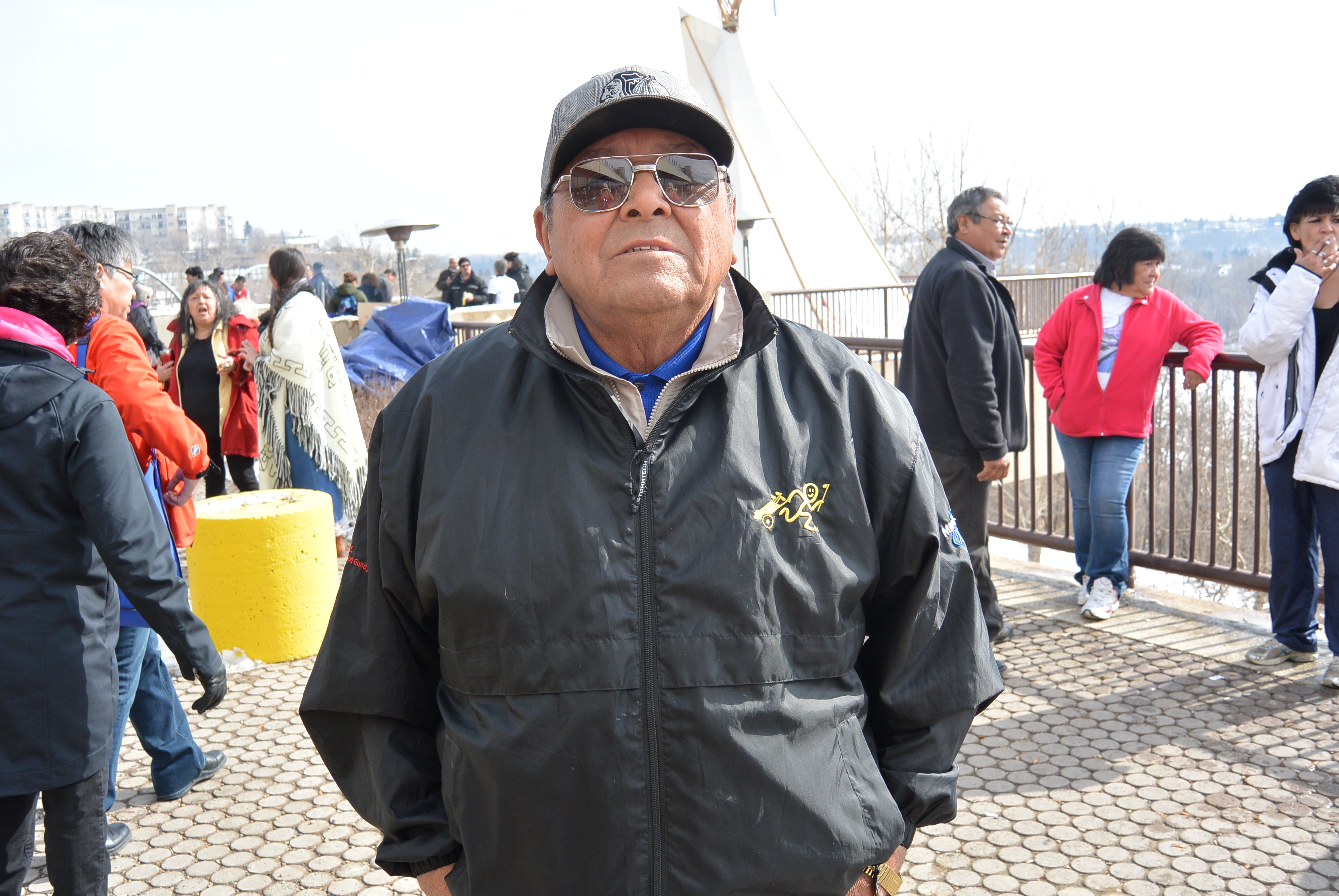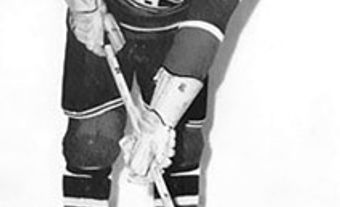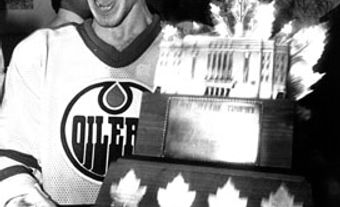Frederick (Fred) George Sasakamoose, CM, hockey player, Elder of Ahtahkakoop Cree Nation (born 25 December 1933 at Whitefish Lake, now Big River First Nation, SK; died 24 November 2020 in Prince Albert, SK). Fred Sasakamoose was one of the first Indigenous hockey players from Canada in the National Hockey League (NHL). A former student of St. Michael’s Indian Residential School in Duck Lake, Saskatchewan, he played 11 games for the Chicago Black Hawks in the 1953–54 NHL season. After his retirement from competitive hockey in 1961, he dedicated himself to encouraging youth through sports involvement. A Member of the Order of Canada, he was inducted into the Saskatchewan First Nations Sports Hall of Fame, the Saskatchewan Sports Hall of Fame, the Saskatchewan Hockey Hall of Fame, the Prince Albert Hall of Fame and the Canadian Native Hockey Hall of Fame.
Early Years
Frederick (Fred) George Sasakamoose was Cree and was born at home at Whitefish Lake (now Big River First Nation), in Saskatchewan. He was raised by his parents, Roderick and Judith “Sugil” (Morin), in a 6 m by 7 m log house on the reserve at Sandy Lake (now Ahtahkakoop Cree Nation), 72 km northwest of Prince Albert, Saskatchewan. His Cree name, given by an elder, means “to stand firm.” He was the second oldest of 11 children, five of whom survived to adulthood. As treaty Indians, the family was registered under the Indian Act. Their lives, work and movement were completely controlled by their local Indian agent, a government employee tasked with administering policy at the ground level.
Sasakamoose was close to his loving family, especially his grandfather, Alexander Sasakamoose. Alexander could neither hear nor speak, but he taught his five-year-old grandson to skate, tying bob skates (double runner ice skates) over his moccasins. A willow branch shaped with an axe was a hockey stick and frozen horse manure stood in for a puck. Sasakamoose practiced skating on a frozen slough while his grandfather fished on a little lake nearby.
Residential School
When Fred Sasakamoose turned seven, a priest, an RCMP officer and an Indian agent visited the family. Although his mother cared for them well and his father was a logger, the Indian agent declared them unfit parents because of their poverty. Sasakamoose and his nine-year-old brother Frank were taken away in a high-sided truck to attend St. Michael’s Indian Residential School, 96 km away in Duck Lake, Saskatchewan. The boys did not know why they were leaving or where they were going. Two years passed before Sasakamoose saw his parents again.
His nine years at residential school were traumatic for the home-loving boy. On arrival, the nuns cut off his braids and ordered him to speak English or be punished. He experienced emotional, physical and sexual abuse. The one joy left to Fred was skating. Although he had no skates of his own, he used oversized skates borrowed from older boys. When he was 10, he was rewarded with his own skates for following school rules and working hard at the endless daily chores such as milking cows and chopping wood.
In 1944, a priest from Montreal, Father Georges Roussel, O.M.I. (Oblates of Mary Immaculate), arrived at the school. Roussel, who became the school’s sports director, pushed Sasakamoose to develop his hockey skills, including a left-hand shot that made him ambidextrous. In the spring of 1949, the school’s team, Duck Lake Ducks, won the provincial midget championship. “I would say Frederick lived for hockey,” Roussel told Brenda Zeman in an interview published in Sundog Highway: Writing from Saskatchewan (2000).
That year, a relieved 15-year-old Sasakamoose finally returned home. The following summer, piling hay in a farmer’s field with his parents, Sasakamoose spotted Roussel and an unknown white man. Sasakamoose and his brother Frank hid nearby, fearing they would have to return to residential school. Instead, the priest and the stranger, George Vogan, asked his parents to allow Fred to attend hockey training camp in Moose Jaw. His potential had been spotted by junior hockey scouts and Vogan wanted him to try out for his team, the Moose Jaw Canucks.
The 16-year-old didn’t want to go, but his parents saw it as a chance to improve his life. Sasakamoose promised his mother he’d be home within two weeks. The same day, Sasakamoose and Vogan drove to Moose Jaw.
Meet Chief Running Deer, Fred Sasakamoose of Ahtahkakoop Cree Nation in Saskatchewan, the first Indigenous player in the NHL.Note: The Secret Life of Canada is hosted and written by Falen Johnson and Leah Simone Bowen and is a CBC original podcast independent of The Canadian Encyclopedia.
Junior Hockey Years
After Fred Sasakamoose arrived in Moose Jaw, he was billeted with George Vogan, general manager of the Moose Jaw Canucks, and his wife, Flora. The Moose Jaw Canucks of the Western Canada Junior Hockey League (WCJHL) was a farm team of the Chicago Black Hawks (now the Chicago Blackhawks).
Sasakamoose’s talent was evident. Less evident was the discomfort he felt being an Indigenous person in a White world. “It was quite a journey, not only to Moose Jaw, but also to live in white society,” he recalled in an interview with Larry Loyie in 2015. At first, he changed into his gear in a corner away from the 80 or so all-white training camp recruits.
After two weeks, many players had been sent home, but Sasakamoose was still training. However, he had promised his mother he would be home in two weeks, and, true to his promise, he determined to walk the 300 km home. He had made it 45 km northward before George Vogan caught up to him. The general manager drove the hungry youth to a café in the town of Chamberlain, fed him and reassured him that he would make the junior team.
Gradually Sasakamoose began to fit in and make friends. He played centre, impressing fans in the 2,000-seat Moose Jaw Arena and elsewhere. He worked hard on his hockey skills, developing his speed, on-ice control and hard shot. “Hockey was everything to me,” Sasakamoose told Loyie.
He played four seasons with the Moose Jaw Canucks; his last game with them was in late February 1954 when they lost in the playoffs to the Regina Pats. Sasakamoose scored 31 goals in 34 games in the 1953–54 season, and was named Most Valuable Player in the WCJHL. A ceremony was held in Edmonton Gardens, where he received a peace pipe and head dress to honour him. “I was recognized as most valuable player and as an Indian. That was something,” Sasakamoose remembered.
Chicago Black Hawks
After their last game of the 1953–54 season, the Moose Jaw Canucks were told to wait in the dressing room for an announcement. Twenty-year-old Fred Sasakamoose was shocked when George Vogan read out a telegram: “Fred Sasakamoose, report immediately to the Chicago Black Hawks.” The dressing room erupted with cheers from his teammates.
Shortly after, six women carried in two suitcases filled with new clothes. “You have to look like a professional,” one told Sasakamoose. The new clothes included the suit and overcoat he wore later that season when he walked into Madison Square Garden in New York City.
On Saturday, 27 February 1954, after a three-day train ride from Moose Jaw to Toronto, Sasakamoose found himself suiting up in Maple Leaf Gardens for his NHL debut. While warming up for the game, he was sent to the penalty box. According to Sasakamoose, broadcaster Foster Hewitt was waiting for him there. “How the hell do you pronounce your name?” Hewitt asked. In 2015, Sasakamoose told author Larry Loyie that, “speaking with Hewitt was the greatest moment of my life that far. I [had] always dreamed of this.”
The famed voice of Hockey Night in Canada did get his name right. Over time, Sasakamoose would have many nicknames, such as Chief Running Deer, Chief Thunder Stick, and Fast Freddy. In Chicago, the organist played “Indian Love Call” when Sasakamoose stepped on the ice.
The NHL league of the era consisted of six teams and included such stars as Gordie Howe, Maurice Richard, Bernie “Boom Boom” Geoffrion and Bill Mosienko. Sasakamoose, No. 21 on the Chicago Black Hawks roster, played centre. He was noted for his speed, dancing footwork and hard slapshot.
In an interview with Brenda Zeman, former Black Hawk and Hockey Hall of Famer Metro Prystai commented that Sasakamoose had “tremendous wrists. He could be fallin[g] down and still get a shot away. And he could skate. He could stop and start on a dime and he could hit top speed in two, maybe three strides. He had the best reflexes I’ve ever seen, better [than] Gordie Howe.”
Sasakamoose played 11 games with the Black Hawks in the 1953–54 season. He scored no goals or assists and collected six penalty minutes. He signed a C-Form contract that guaranteed $6,000 if he played with the Chicago Black Hawks the following season, $3,500 if he went to the American Hockey League, and $3,000 if he played with a lesser farm team.
The season ended, and he went home to his parents. Home was where he had wanted to be since he was a lonely seven-year-old in residential school. He had bought himself a new car, a flashy Dodge DeSoto, and took his parents into Prince Albert, Saskatchewan, for food to fill their empty cupboards. He bought his father a buggy and a team of horses and silk cloth for his mother to sew a new dress. Then, according to Sasakamoose, he went into town and got drunk. His drinking would continue until 1980 when he became chief of Sandy Lake Indian Band.
Playing in the Minors
While at home, Fred Sasakamoose did not keep up with his training and failed to make the cut for the 1954–55 season with the Chicago Black Hawks. However, he continued to play with affiliated teams, including the Westminster Royals (1954–55) and Chicoutimi Sagueneens (1954–55).
On 22 July 1955, he married Loretta Isbister from Bodwin, Saskatchewan. Loretta’s mother was from the reserve at Sandy Lake and the 20-year-old bride was comfortable there, reluctant to move to Chicago even if her husband had the chance to play with the Hawks again.
At the start of the 1955–56 season, Sasakamoose played for the Calgary Stampeders of the Western Hockey League. After two games with the Stampeders, he had had enough. His wife didn’t want to leave home and hadn’t come to see him play even when he was in Saskatoon. He left and went home to Loretta at Sandy Lake, taking a 1,000 km taxi ride from Calgary to be with her.
The Black Hawks refused to grant him amateur status until the following year. Once again an amateur, he played for Kamloops Chiefs in the Okanagan Senior Hockey League (1956–58 and 1959–60). Loretta lived with him in Kamloops while he played for the Chiefs. He finished his career with the North Battleford Beavers (1960–61).
Sports and Community
After retiring from competitive hockey, Fred Sasakamoose farmed, trapped, and hunted from his home base at Sandy Lake, but never forgot his love of hockey and belief in the power of sports to improve lives. From 1961 onward, he used his fame to promote opportunities for youth in sports, including hockey, long-distance running, track and field, soccer and basketball.
In 1962, Sasakamoose was a founding member of the Northern Indian Hockey League. He was also a founding member of many initiatives, including the Saskatchewan Indian Summer and Winter Games, Saskatoon’s All Nations Hockey School and Fred Sasakamoose All Star Hockey Week, a multi-racial hockey camp. He served on the NHL Ethnic Diversity Task Force and was a board member for the Aboriginal Healing Foundation.
Community Leader
From 1980 to 1984, Fred Sasakamoose was chief of the Sandy Lake Indian Band. As chief, he decided to stop drinking in order to become a true role model for his family and community. It was also at this point that he began to heal from the trauma he felt at residential school.
Part of this healing was learning to speak fluent Cree again. “In school, the Cree language was totally outlawed. You would get a severe punishment. When I came home as a child, I couldn’t even say spoon or fork in Cree. I had to point to get it across to my mom. It wasn’t easy to relearn my language but it was important to me to be able to speak to my family, to be recognized as belonging to the Cree nation,” he told Larry Loyie in 2015.
Following his term as chief of the Sandy Lake Indian Band, Sasakamoose was a band councillor for 35 years before becoming a senator with the Federation of Saskatchewan Indian Nations.
He and his wife Loretta were Elders of Ahtahkakoop Cree Nation. They have nine children, and many grandchildren and great-grandchildren. Sasakamoose continued to actively promote youth and sports activities, teaching traditional ways of hunting, fishing and trapping at cultural camps. As an elder with the reserve’s community school, he counselled youth with drug and alcohol addictions issues. He died in Prince Albert on 24 November 2020 at age 86 after being diagnosed with COVID-19.
Legacy and Honours
Fred Sasakamoose helped break the racial barrier for Indigenous hockey players in the NHL. “It’s a different world for them now,” he told author Larry Loyie. “They compete in the outside world, starting as young kids.” He is satisfied with his life and how it worked out. “I didn’t have freedom when I played hockey. I now have freedom to do the things I love. I have no regrets. I’m happy with the choices I made.”
Sasakamoose was recognized for his achievements and contributions by the Assembly of First Nations and the Federation of Saskatchewan Indian Nations (FSIN), as well as other community and sports organizations. In 1994, Saskamoose was one of the first athletes to be inducted into the Saskatchewan First Nations Sports Hall of Fame. He was inducted into the Saskatchewan Sports Hall of Fame in 2007 and the Saskatchewan Hockey Hall of Fame in 2012. He was also inducted into the Prince Albert Hall of Fame and the Canadian Native Hockey Hall of Fame. In 2011, he received a prestigious National Aboriginal Achievement Award (now the Indspire Awards). He also received an FSIN Circle of Honour Award and a Meadow Lake Wall of Fame Award. In 2017, Sasakamoose was made a Member of the Order of Canada and received an honorary diploma from Saskatchewan Polytechnic.
DID YOU KNOW?
On 18 May 2021, Sasakamoose’s posthumous memoir Call Me Indian: From the Trauma of Residential School to Becoming the NHL’s First Treaty Indigenous Player was released.

 Share on Facebook
Share on Facebook Share on X
Share on X Share by Email
Share by Email Share on Google Classroom
Share on Google Classroom






